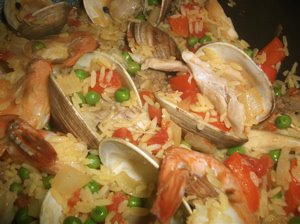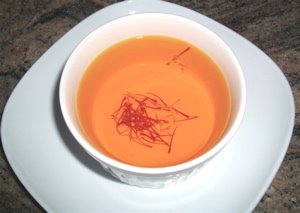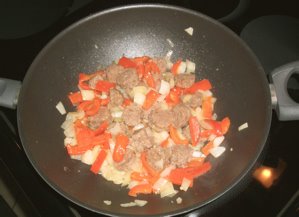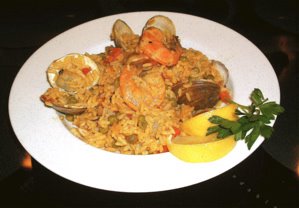 I used to make this recipe in England, and now make it here in California with slightly different ingredients. If you do not know Paella, it is an everyday Spanish dish, and its ingredients vary greatly, but the nearer you are to the coast, the more seafood it will contain. As well as seafood, it also contains chicken and pork (even if in the form of sausage or ham).
I used to make this recipe in England, and now make it here in California with slightly different ingredients. If you do not know Paella, it is an everyday Spanish dish, and its ingredients vary greatly, but the nearer you are to the coast, the more seafood it will contain. As well as seafood, it also contains chicken and pork (even if in the form of sausage or ham).
Ingredients (serves 4)1 lb clams (littlenecks are good)1/2 lb shell on large shrimp2 cooked boneless chicken breasts2 mild italian or chorizo sausages1 medium sized red pepper1 can diced tomatoes1 tbsp. olive oil1/2 large onion chopped1 crushed garlic clove12 oz bottled clam juice1/2 glass dry white wine10 oz long grain riceSaffron threads (infused)5 oz fresh or frozen peas (thawed)Salt & pepper to tasteLemon & parsley garnishYou can vary the ingredients by adding mussels, langostinos, or lobster and you can use ham or pork instead of sausage. 1. Prepare the shellfish. Wash the shrimp under running water, and scrub the clams and leave to soak to remove any sand (if they are particularly sandy, leave them for 5-6 hours).
1. Prepare the shellfish. Wash the shrimp under running water, and scrub the clams and leave to soak to remove any sand (if they are particularly sandy, leave them for 5-6 hours). 2. Pour boiling water on the saffron threads and leave to infuse for 15-20 minutes.3. Chop the onion into small pieces, and crush the garlic.4. Remove the seeds from the pepper and cut into strips.
2. Pour boiling water on the saffron threads and leave to infuse for 15-20 minutes.3. Chop the onion into small pieces, and crush the garlic.4. Remove the seeds from the pepper and cut into strips. 5. Part cook the sausage in a frying pan with a little cold water for about 6 minutes. Remove from pan and leave for a few minutes to cool. Blot with a paper towel to remove excess fat and remove the skin with scissors. Cut the sausage into small pieces.
5. Part cook the sausage in a frying pan with a little cold water for about 6 minutes. Remove from pan and leave for a few minutes to cool. Blot with a paper towel to remove excess fat and remove the skin with scissors. Cut the sausage into small pieces. 6. Heat the olive oil in a frying pan and lightly fry the onion and crushed garlic until the onion is transparent. Add the part cooked sausage and fry over a high heat. Add the pepper to this mixture and cook for five minutes.
6. Heat the olive oil in a frying pan and lightly fry the onion and crushed garlic until the onion is transparent. Add the part cooked sausage and fry over a high heat. Add the pepper to this mixture and cook for five minutes. 7. Add the cooked chicken and tomatoes. Cook gently for 2 minutes before adding the white wine, saffron liquid, and about half the clam juice. Stir well.8. Stir in the rice, then bring the mixture to the boil.
7. Add the cooked chicken and tomatoes. Cook gently for 2 minutes before adding the white wine, saffron liquid, and about half the clam juice. Stir well.8. Stir in the rice, then bring the mixture to the boil. 9. Add the shrimp and the clams and stir well. Cook with the lid on for approx. 20 minutes, until the rice is cooked. Check frequently while cooking, as the rice absorbs the liquid quickly, so add more clam juice as needed. 10. Serve with lemon wedges and parsely garnish. Enjoy!
9. Add the shrimp and the clams and stir well. Cook with the lid on for approx. 20 minutes, until the rice is cooked. Check frequently while cooking, as the rice absorbs the liquid quickly, so add more clam juice as needed. 10. Serve with lemon wedges and parsely garnish. Enjoy!
 This is the kind of meal to share with friends, sitting around the table enjoying the flavor of the mussels, dipping crusty bread in the juices at the bottom of the bowl, and drinking a glass of white wine, or your favorite ice cold beer.You should buy the mussels on the day that you are going to cook them, and scrub and debeard them in advance of cooking.Ingredients (serves 4)
This is the kind of meal to share with friends, sitting around the table enjoying the flavor of the mussels, dipping crusty bread in the juices at the bottom of the bowl, and drinking a glass of white wine, or your favorite ice cold beer.You should buy the mussels on the day that you are going to cook them, and scrub and debeard them in advance of cooking.Ingredients (serves 4)- 4 lbs mussels, scrubbed and debearded
- 1 cup dry white wine
- 2 cloves garlic, finely chopped
- 1 tablespoons flat leafed parsley, plus a little for garnish
- 4 scallions, cut into 1-inch pieces
- 1 tablespoon olive oil
- 2 red chiles finely chopped
- 1 large baguette
Method
- Place the olive oil in a large wide pot over medium heat.
- Add the garlic and saute for about 2 minutes.
- Add the scallions and the chiles and saute for another minute.
- Add the mussels, and toss quickly to coat.
- Add the white wine and and cover the pot.
- Continue to cook over a medium-high heat for about 3 minutes, or until the mussels begin to open. Discard any mussels that do not open.
- Add the tablespoon of chopped parsley, and toss to combine.
- Continue cooking until all the mussels have opened.
- Place the mussels in warmed serving bowls, or one large bowl (family style) and spoon over the wine mixture.
- Sprinkle with the additional parsley, and serve immediately with the baguette.

After attending a seminar at one of the food shows recently, I learned that many people would like to do more cooking, and prepare interesting midweek meals for themselves and their families, but there just isn't the time. New technology has meant that everyone is on call 24/7, and with mobile phones, emails, and text messages with you all the time, no wonder we all feel frazzled!With this in mind, I searched for some time saving products to add to the Gourmet Fusion store, and found these two ready-made paella meals.

One is a seafood paella, and one is vegetable paella. Both are fully cooked and ready to serve.They come in a ready to heat, easy-open tin that is in a microwave safe dish. To prepare the meal you can either place the contents of the tin into the enclosed microwave-safe tray and heat, place the tin as-is in boiling water, or simply empty the contents into a pot on the stove. They are made from all natural ingredients with no added preservatives or coloring. They are both available in the Gourmet Fusion online store and our Solana Beach store in Leaping Lotus, and definitely worth a try!
 Go into any seafood restaurant or any steak house, and you are sure to see clam chowder offered on the menu. Clam chowder is typical of most regional specialties in that there is no one recipe - instead there are many varieties all containing the same base ingredients. The basic ingredients of a clam chowder are clams, onions and potatoes, and bacon or ham, giving the soup its distinctive smoky flavor. For a rich New England clam chowder, milk is often replaced with cream. In Manhattan clam chowder, however, there is neither milk nor cream, but plenty of fresh vegetables.My favorite restaurant for clam chowder is San Francisco's Hog Island Oyster Company, which serves a whole array of oysters prepared in various ways, and clams either steamed or in a chowder, and the freshest salads you could ever taste. All of the vegetables are grown locally, and the menu changes according to whatever is in season.Their clam chowder is different to many in that they leave the clams in the shells and serve them in a creamy broth, rather than chopping the clams and cooking them in a thick sauce. If you want to make chowder yourself, here is my version of this style of clam chowder.Ingredients (serves 4)
Go into any seafood restaurant or any steak house, and you are sure to see clam chowder offered on the menu. Clam chowder is typical of most regional specialties in that there is no one recipe - instead there are many varieties all containing the same base ingredients. The basic ingredients of a clam chowder are clams, onions and potatoes, and bacon or ham, giving the soup its distinctive smoky flavor. For a rich New England clam chowder, milk is often replaced with cream. In Manhattan clam chowder, however, there is neither milk nor cream, but plenty of fresh vegetables.My favorite restaurant for clam chowder is San Francisco's Hog Island Oyster Company, which serves a whole array of oysters prepared in various ways, and clams either steamed or in a chowder, and the freshest salads you could ever taste. All of the vegetables are grown locally, and the menu changes according to whatever is in season.Their clam chowder is different to many in that they leave the clams in the shells and serve them in a creamy broth, rather than chopping the clams and cooking them in a thick sauce. If you want to make chowder yourself, here is my version of this style of clam chowder.Ingredients (serves 4)- 6 lb manila clams, soaked and scrubbed clean
- 6 rashers bacon
- 1 clove garlic, crushed
- 1 small onion, diced
- 2 medium carrots, diced
- 2 medium celery stalks, diced
- 3 medium potatoes, peeled and diced
- 3 cups clam broth
- 4 cups cream or half and half
- 1 cup dry white wine
- 4 sprigs of thyme
- salt
- freshly ground black pepper
Method
- Scrub the clams thoroughly under running water, and leave to soak for several hours to remove any sand.
- Heat a 6-quart pot over a medium heat. Fry the bacon for about 5 minutes and then add the garlic and diced vegetables to the pan. Stir gently for about 5 minutes.
- Add the clams and the thyme to the vegetable mixture, then add 3 cups of the clam broth and 1 cup of wine, season with salt and pepper.
- Cook gently until the clams open, discarding any that do not.
- Add the cream to the mixture and bring to the boil, then reduce the heat to a simmer, stirring frequently.
- All the ingredients should be cooked through, but the potatoes should be in tact and the chowder should be neither too runny nor too dry.
Serve with a crispy sourdough roll, a fresh salad, and a glass of white wine or a chilled wheat beer, and it's truly heaven!
 Many of us try to include more fish in our diet because we are aware of the beneficial effects on our hearts and our health in general. The summer is a great time for barbecuing fish and the supermarkets have an abundance of wonderful looking fish and seafood available.However, quite often people worry about the safety of eating certain seafood, especially if it is farmed overseas, and for those ecologically minded people, the worry of over-farming fish is of great concern many of us would like see greater use being made of protected areas to safeguard fish stocks. Scientists at Stanford University predicted some time ago that unless we change the way we manage all the ocean species together, as working ecosystems, then this century will be the last century of wild seafood. So I was interested to learn about a new resource for consumers and retailers which gives information about fish and other seafood in the U.S in the form of a website run by the U.S. National Oceanic and Atmospheric Administration’s Fisheries Service (NOAA Fisheries). The website, called “FishWatch – U.S. Seafood Facts” should help people identify the status of fishery stocks and understand the management and science requirements involved with building and maintaining sustainable fisheries. You can visit this site at www.nmfs.noaa.gov/fishwatch.If you are at all concerned about your diet, and knowing whether you are buying sustainably sourced fish in supermarkets, check out this site, which also provides nutrition information and other interesting facts about U.S. fisheries, and over the next 60 days is inviting comments from readers to help evaluate and improve its website.
Many of us try to include more fish in our diet because we are aware of the beneficial effects on our hearts and our health in general. The summer is a great time for barbecuing fish and the supermarkets have an abundance of wonderful looking fish and seafood available.However, quite often people worry about the safety of eating certain seafood, especially if it is farmed overseas, and for those ecologically minded people, the worry of over-farming fish is of great concern many of us would like see greater use being made of protected areas to safeguard fish stocks. Scientists at Stanford University predicted some time ago that unless we change the way we manage all the ocean species together, as working ecosystems, then this century will be the last century of wild seafood. So I was interested to learn about a new resource for consumers and retailers which gives information about fish and other seafood in the U.S in the form of a website run by the U.S. National Oceanic and Atmospheric Administration’s Fisheries Service (NOAA Fisheries). The website, called “FishWatch – U.S. Seafood Facts” should help people identify the status of fishery stocks and understand the management and science requirements involved with building and maintaining sustainable fisheries. You can visit this site at www.nmfs.noaa.gov/fishwatch.If you are at all concerned about your diet, and knowing whether you are buying sustainably sourced fish in supermarkets, check out this site, which also provides nutrition information and other interesting facts about U.S. fisheries, and over the next 60 days is inviting comments from readers to help evaluate and improve its website.
 What is the difference between a shrimp and a prawn? The terms shrimps and prawns used in the fish trade have no scientific basis. They are usually no more than an indication of the size of some of the 2,000 - 3,000 known species. Shrimp is usually the term applied to small prawns with over 100 to a pound in weight. Most of these are deep-sea creatures. The Gray or Brown Shrimp and the East Asian King Prawn live in shallow coastal waters. In addition to subdivisions based on size and depth of water, there is also a distinction between warm and cold-water prawns. Cold water prawns are better quality and, therefore, more expensive.
What is the difference between a shrimp and a prawn? The terms shrimps and prawns used in the fish trade have no scientific basis. They are usually no more than an indication of the size of some of the 2,000 - 3,000 known species. Shrimp is usually the term applied to small prawns with over 100 to a pound in weight. Most of these are deep-sea creatures. The Gray or Brown Shrimp and the East Asian King Prawn live in shallow coastal waters. In addition to subdivisions based on size and depth of water, there is also a distinction between warm and cold-water prawns. Cold water prawns are better quality and, therefore, more expensive.
On top of this confusion, the use of the terms shrimp and prawn is not consistent throughout the world. They are usually sorted and named by their size but the system is different in Britain, Europe and the United States. The only point common to all of them is that extremely large prawns are sold as giant, king or tiger prawns.  Whether you are buying shrimps or prawns, you still have to figure out how to prepare them. You can buy them in most supermarkets either cooked, uncooked, with shell on or simply tail on, but there is no doubt that shrimp with the shell still in tact add more flavor to a recipe.
Whether you are buying shrimps or prawns, you still have to figure out how to prepare them. You can buy them in most supermarkets either cooked, uncooked, with shell on or simply tail on, but there is no doubt that shrimp with the shell still in tact add more flavor to a recipe.
Some supermarkets will devein the raw shrimp for you, but if not, you can make your work easy with a simple shrimp deveiner like the one shown here. This is a relatively inexpensive tool and comes in handy for many seafood preparation jobs.
To use the deveiner on raw shrimp, first run a sharp knife down its back, exposing the vein, then push the shrimp deveiner along the back, removing the vein, then rinse under cold water. This leaves the shell still in tact with the vein removed ready to add to your lobster boil, or paella recipe.
If using on cooked shrimp, first cook the shrimp. Then, if their heads are still attached, remove them. Hold the shrimp under running water and peel off the shell working toward the tail. Push the shrimp deveiner along the back, and they are ready to use in your favorite shrimp cocktail. Shrimp deveiners like the one shown here can be found in the Gourmet Fusion store, along with many other useful seafood tools.
 I used to make this recipe in England, and now make it here in California with slightly different ingredients. If you do not know Paella, it is an everyday Spanish dish, and its ingredients vary greatly, but the nearer you are to the coast, the more seafood it will contain. As well as seafood, it also contains chicken and pork (even if in the form of sausage or ham).
I used to make this recipe in England, and now make it here in California with slightly different ingredients. If you do not know Paella, it is an everyday Spanish dish, and its ingredients vary greatly, but the nearer you are to the coast, the more seafood it will contain. As well as seafood, it also contains chicken and pork (even if in the form of sausage or ham). 1. Prepare the shellfish. Wash the shrimp under running water, and scrub the clams and leave to soak to remove any sand (if they are particularly sandy, leave them for 5-6 hours).
1. Prepare the shellfish. Wash the shrimp under running water, and scrub the clams and leave to soak to remove any sand (if they are particularly sandy, leave them for 5-6 hours). 2. Pour boiling water on the saffron threads and leave to infuse for 15-20 minutes.
2. Pour boiling water on the saffron threads and leave to infuse for 15-20 minutes. 5. Part cook the sausage in a frying pan with a little cold water for about 6 minutes. Remove from pan and leave for a few minutes to cool. Blot with a paper towel to remove excess fat and remove the skin with scissors. Cut the sausage into small pieces.
5. Part cook the sausage in a frying pan with a little cold water for about 6 minutes. Remove from pan and leave for a few minutes to cool. Blot with a paper towel to remove excess fat and remove the skin with scissors. Cut the sausage into small pieces. 6. Heat the olive oil in a frying pan and lightly fry the onion and crushed garlic until the onion is transparent. Add the part cooked sausage and fry over a high heat. Add the pepper to this mixture and cook for five minutes.
6. Heat the olive oil in a frying pan and lightly fry the onion and crushed garlic until the onion is transparent. Add the part cooked sausage and fry over a high heat. Add the pepper to this mixture and cook for five minutes. 7. Add the cooked chicken and tomatoes. Cook gently for 2 minutes before adding the white wine, saffron liquid, and about half the clam juice. Stir well.
7. Add the cooked chicken and tomatoes. Cook gently for 2 minutes before adding the white wine, saffron liquid, and about half the clam juice. Stir well. 9. Add the shrimp and the clams and stir well. Cook with the lid on for approx. 20 minutes, until the rice is cooked. Check frequently while cooking, as the rice absorbs the liquid quickly, so add more clam juice as needed.
9. Add the shrimp and the clams and stir well. Cook with the lid on for approx. 20 minutes, until the rice is cooked. Check frequently while cooking, as the rice absorbs the liquid quickly, so add more clam juice as needed. 









